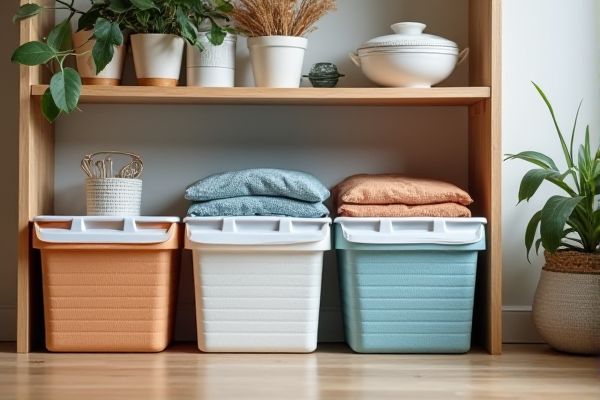
Plastic bins offer sturdy, waterproof storage ideal for heavy-duty organization, while fabric bins provide lightweight, breathable options perfect for flexible and decorative use. Discover which storage solution best fits Your needs by reading the rest of the article.
Table of Comparison
| Feature | Plastic Bins | Fabric Bins |
|---|---|---|
| Material | Durable polyethylene or polypropylene | Canvas, polyester, or cotton fabric |
| Durability | High impact resistance, long-lasting | Less durable, prone to wear and tear |
| Weight | Heavier | Lightweight and easy to carry |
| Flexibility | Rigid structure | Flexible and collapsible |
| Moisture Resistance | Waterproof and easy to clean | Absorbs moisture, not waterproof |
| Storage Capacity | Fixed volume, stackable | Expandable but less structured |
| Appearance | Glossy, solid colors | Soft texture, varied patterns |
| Cost | Moderate to high | Generally lower cost |
| Common Uses | Garage, warehouse, outdoor storage | Closets, nurseries, lightweight storage |
Introduction to Storage Solutions
Plastic bins offer durability and water resistance for long-term storage, making them ideal for safeguarding valuables in humid or damp environments. Fabric bins, on the other hand, provide lightweight, breathable storage options that are perfect for organizing soft items like clothes or linens while adding a decorative touch to your space. Your choice depends on whether you prioritize sturdiness and protection or flexibility and style in your storage solutions.
Overview of Plastic Bins
Plastic bins offer durable, waterproof storage solutions ideal for organizing heavy or damp items. Their rigid construction provides superior stackability and protection against pests and moisture compared to fabric bins. Available in various sizes and clear options, plastic bins enhance visibility and accessibility for efficient storage management.
Overview of Fabric Bins
Fabric bins offer lightweight and flexible storage solutions ideal for organizing closets, shelves, and playrooms. Made from durable materials like cotton, canvas, or polyester, they provide breathability and can be easily folded when not in use. Their soft structure reduces the risk of injury and enhances aesthetic appeal, making them a popular choice for homes seeking both functionality and style.
Durability and Longevity
Plastic bins offer superior durability and longevity due to their resistance to moisture, pests, and impact, making them ideal for long-term storage in various environments. Fabric bins, while lightweight and flexible, tend to wear out faster as they can tear, absorb moisture, and lose shape over time. Choosing plastic bins ensures your stored items remain protected and your storage solution lasts significantly longer.
Flexibility and Versatility
Plastic bins offer rigid structure and durability, making them ideal for stacking and long-term storage in garages or warehouses. Fabric bins provide lightweight flexibility, easily collapsing when not in use and fitting into irregular spaces, perfect for closets or temporary storage needs. Both types enhance organization, with fabric bins excelling in portability and plastic bins in sturdiness.
Maintenance and Cleaning
Plastic bins offer easy maintenance and cleaning due to their non-porous surfaces, which resist stains and can be wiped down quickly with soap and water. Fabric bins require more careful upkeep, often needing spot cleaning or gentle machine washes to avoid damage or shrinkage. You'll find plastic bins more convenient for frequent cleaning, while fabric bins demand a softer touch to maintain their appearance and longevity.
Environmental Impact
Plastic bins contribute significantly to environmental pollution due to their non-biodegradable nature and reliance on fossil fuels for production, leading to increased carbon emissions. Fabric bins, often made from natural or recycled materials, offer a more sustainable alternative by reducing landfill waste and promoting biodegradability. Choosing fabric bins can help minimize your carbon footprint and support eco-friendly storage solutions.
Cost Comparison
Plastic bins generally have a higher upfront cost compared to fabric bins but offer greater durability and long-term value due to their resistance to wear and tear. Fabric bins are typically more affordable initially, making them ideal for short-term or lightweight storage needs. When evaluating cost effectiveness, consider the frequency of use and environmental exposure as plastic bins minimize replacement expenses over time despite the higher initial investment.
Ideal Uses for Plastic Bins vs Fabric Bins
Plastic bins are ideal for storing items that require protection from moisture, pests, and heavy-duty use, such as tools, seasonal decorations, and craft supplies, due to their sturdy and waterproof construction. Fabric bins are best suited for organizing lightweight, soft items like clothing, toys, and linens, offering breathable storage that prevents mold and odors. Choosing between plastic and fabric bins depends on the need for durability and moisture resistance versus flexibility and breathability in storage solutions.
Final Verdict: Which Bin is Best for You?
Plastic bins offer durability, moisture resistance, and stackability, making them ideal for long-term storage and heavy-duty organization. Fabric bins provide lightweight convenience, breathability, and aesthetic appeal, perfect for easy access and decorative purposes. Your choice depends on whether you prioritize sturdiness and protection or flexibility and style in your storage solution.
 homyna.com
homyna.com